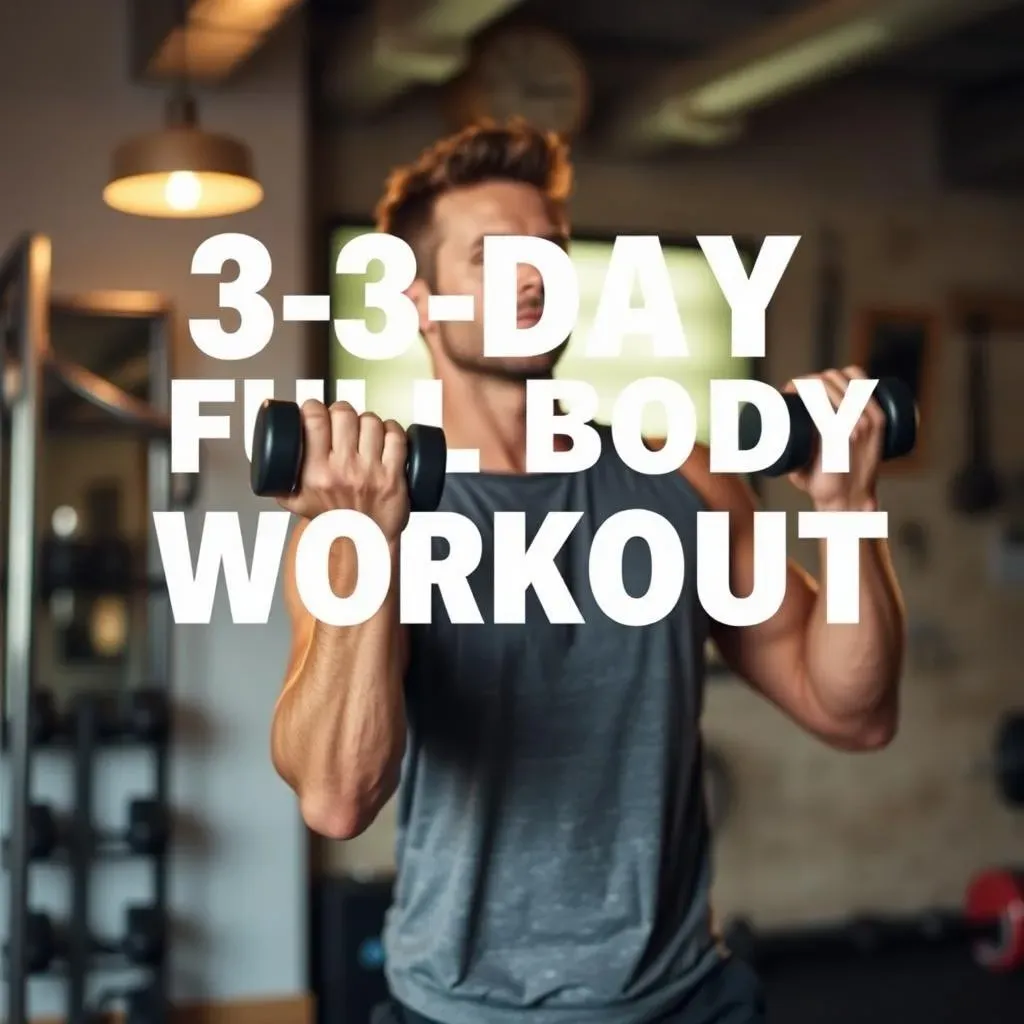Table of Contents
Want to build full-body strength without stepping foot in a gym? You're in the right spot. This guide will show you how to crush your fitness goals with a simple, effective dumbbell workout at home full body routine. Forget complicated machines and crowded spaces. We're breaking down a straightforward 3-day program designed for awesome results. We'll cover the key exercises that hit every major muscle group, making sure you're using your dumbbells efficiently. Plus, we'll share essential tips on how to progress your workouts and, just as importantly, how to recover properly. Ready to transform your home into your personal powerlifting arena? Let's get started!
Your 3Day Dumbbell Workout at Home for a Full Body Transformation

Your 3Day Dumbbell Workout at Home for a Full Body Transformation
Alright, so you're itching for a change and dumbbells are your weapon of choice? Awesome! This 3-day split is your ticket to a full-body transformation, right from your living room. We're talking about hitting all the major muscle groups – legs, chest, back, shoulders, and arms – without needing a ton of fancy equipment. Think of it like this: Monday you're powering through squats and presses, Wednesday is for pulling and deadlifts, and Friday you're finishing strong with a mix of everything. This isn't about marathon gym sessions; it's about focused effort and smart exercises that deliver results. Trust me, you'll feel it, and more importantly, you'll see it.
Essential Dumbbell Exercises for a Full Body Workout at Home

Essential Dumbbell Exercises for a Full Body Workout at Home
so what moves are non-negotiable for a killer dumbbell workout at home full body session? Think of these as your foundational exercises. First up, squats. Seriously, don't skip leg day, even at home. Grab those dumbbells, hold them at your sides or on your shoulders, and squat like you're about to sit on an invisible chair. Feel the burn in your quads and glutes. Next, we've got dumbbell bench presses. Lay on the floor or a bench, dumbbells in hand, and push those weights straight up. This hits your chest, shoulders, and triceps. For your back, bent-over rows are gold. Hinge at your hips, keep your back straight, and pull the dumbbells towards your chest. Your back muscles will thank you. Don't forget overhead presses for your shoulders. Standing or seated, push the dumbbells straight overhead. And for those arm muscles everyone loves to work, we've got bicep curls and triceps extensions. Curl the dumbbells up towards your shoulders for biceps, and extend them overhead or behind your head for triceps. These exercises are your bread and butter.
Now, let's break down the essentials a bit more. It's not just about doing the exercises; it's about doing them right. Focus on controlled movements. Don't just fling the weights around. Think about squeezing the muscles you're working. For example, during a bicep curl, really focus on contracting your bicep at the top of the movement. Also, don't be afraid to experiment with variations. For squats, try goblet squats where you hold one dumbbell close to your chest. For lunges, you can do forward lunges, reverse lunges, or even walking lunges to add a bit more spice. The key is to keep challenging yourself. And remember, proper form trumps heavy weight every single time. It's better to do the exercise correctly with a lighter weight than to risk injury with a weight that's too heavy.
Speaking of the essentials, here's a quick rundown of those key exercises we just talked about:
Exercise | Target Muscles |
|---|---|
Dumbbell Squats | Quads, Glutes, Hamstrings |
Dumbbell Bench Press | Chest, Shoulders, Triceps |
Bent-Over Rows | Back, Biceps |
Overhead Press | Shoulders |
Bicep Curls | Biceps |
Triceps Extensions | Triceps |
Progressing Your Dumbbell Workout at Home: Tips and Tricks

Progressing Your Dumbbell Workout at Home: Tips and Tricks
Spice It Up: Variations and Intensity
Alright, doing the same old routine can get stale faster than week-old bread. So, how do you keep things interesting and, more importantly, keep making progress with your dumbbell workout at home full body? Think about exercise variations. Remember those squats? Try single-leg squats or jump squats when you're feeling spicy. Bench presses getting easy? Switch to incline or decline presses by propping yourself up on pillows or a sturdy box. For rows, try alternating dumbbell rows. Little tweaks can make a big difference. Another trick? Play with intensity. This doesn't just mean lifting heavier (though that's part of it). It also means shortening your rest times between sets. Instead of chilling for a full minute, try cutting it down to 30 or 45 seconds. You'll be surprised how much harder your muscles have to work.
Consider this: if you're consistently hitting your target reps with ease, it's a clear sign your muscles are adapting. That's good! It means you're getting stronger. But to keep seeing results, you need to keep challenging them. Don't be afraid to nudge yourself outside your comfort zone. It's where the magic happens. But, and this is a big BUT, always prioritize good form. It's better to do a harder variation with a lighter weight and perfect form than to butcher the movement with a weight that's too heavy. Listen to your body, but also push it when you know you've got more in the tank.
The Numbers Game: Sets, Reps, and Weight
Let's talk numbers because they matter when you're progressing your dumbbell workout at home full body. A common approach is to start with 3 sets of 8-12 repetitions for most exercises. This range is generally good for building muscle. However, as things get easier, you've got options. You can increase the number of sets. Instead of 3, try 4. You can also increase the number of reps. If 12 reps feel easy, aim for 15. But the most direct way to progress is by increasing the weight you're lifting. This is where those adjustable dumbbells really shine! Even small increases, like 2.5 pounds, can make a difference over time. Don't go crazy and try to jump up 10 pounds at once, especially if your form suffers.
Think of it like climbing a staircase. Each step (increase in weight, reps, or sets) takes you higher. It's a gradual process, not a sprint. Keep a workout journal or use an app to track your progress. Note down the exercises you did, the weight you used, and how many reps you managed. This will give you a clear picture of how far you've come and help you plan your next steps. Seeing that progress on paper can be a huge motivator too! It's proof that your hard work is paying off.
Progression Method | How It Works | When to Implement |
|---|---|---|
Increase Weight | Lift heavier dumbbells. | When you can comfortably complete all sets and reps with good form. |
Increase Reps | Do more repetitions per set. | When your current rep range feels too easy. |
Increase Sets | Add more sets to your workout. | As your endurance improves. |
Decrease Rest Time | Shorten the breaks between sets. | To increase workout intensity. |
Exercise Variations | Switch to more challenging versions of exercises. | To target muscles differently and prevent plateaus. |
Listen to Your Body: Recovery and Rest in Your Full Body Dumbbell Routine

Listen to Your Body: Recovery and Rest in Your Full Body Dumbbell Routine
The Importance of Rest Days
you're crushing your dumbbell workout at home full body sessions, feeling stronger, and seeing progress. That's awesome! But here's a secret weapon that's just as important as the workout itself: rest. I know, I know, it sounds counterintuitive. You're eager to keep going, but trust me on this. Rest days aren't for the weak; they're for the smart. Think of your muscles like tiny construction crews. When you work out, you're essentially causing tiny tears in the muscle fibers. Rest is when those crews come in to repair and rebuild, making your muscles bigger and stronger. Skipping rest days is like overworking your construction crew – they get tired, their work suffers, and eventually, something breaks down. Give your body the time it needs to recover and you'll come back stronger and ready to lift more.
Spotting the Signals: When to Ease Off
Learning to listen to your body is key. It's not always easy, especially when you're motivated, but it's crucial for a sustainable dumbbell workout at home full body routine. There's a difference between the good kind of muscle soreness (that "I worked hard" feeling) and the bad kind (that "something's wrong" feeling). Sharp, persistent pain is a red flag. Don't push through it. It's your body's way of saying, "Hey, knock it off!" Excessive fatigue is another signal. Feeling constantly drained, even on your rest days? That's a sign you might be overdoing it. Sleep is also a big indicator. If you're struggling to sleep or your sleep quality has tanked, it could be due to overtraining. Pay attention to these signals and don't be afraid to adjust your routine. Maybe take an extra rest day, reduce the intensity, or focus on active recovery like a light walk or stretching.
Fueling Recovery: Nutrition and Sleep
Rest isn't just about taking days off from lifting. It's also about what you do outside of your workouts to support recovery. Think of it like this: your body is a high-performance machine, and it needs the right fuel and maintenance. Nutrition plays a huge role. Make sure you're eating enough protein to help those muscles rebuild. Carbs are important for replenishing energy stores, and don't skimp on healthy fats. Hydration is also key – water helps transport nutrients and flush out waste products. And then there's sleep. Seriously, don't underestimate the power of a good night's sleep. Aim for 7-9 hours of quality sleep. It's during sleep that a lot of that muscle repair and growth happens. Think of it as your body's nightly tune-up. Get these recovery pillars in place, and you'll not only feel better but also see better results from your hard work.
Recovery Element | Why It's Important | Tips for Implementation |
|---|---|---|
Rest Days | Allows muscle repair and growth; prevents overtraining. | Schedule 1-2 rest days per week; listen to your body. |
Nutrition | Provides building blocks for muscle repair and energy. | Focus on protein, carbs, healthy fats, and hydration. |
Sleep | Crucial for muscle recovery and overall well-being. | Aim for 7-9 hours of quality sleep per night. |
Active Recovery | Promotes blood flow and reduces muscle soreness. | Light cardio, stretching, yoga on rest days. |
Wrapping Up Your Full Body Dumbbell Journey at Home
So, you've got the tools and the know-how to kickstart your dumbbell workout at home full body routine. Remember, consistency is key. It's about those regular sessions, pushing yourself just a little bit more each time, and listening to your body. This isn't a sprint; it's a marathon towards a stronger, healthier you. Keep those dumbbells handy, stay focused, and watch the progress unfold. You've got this!
